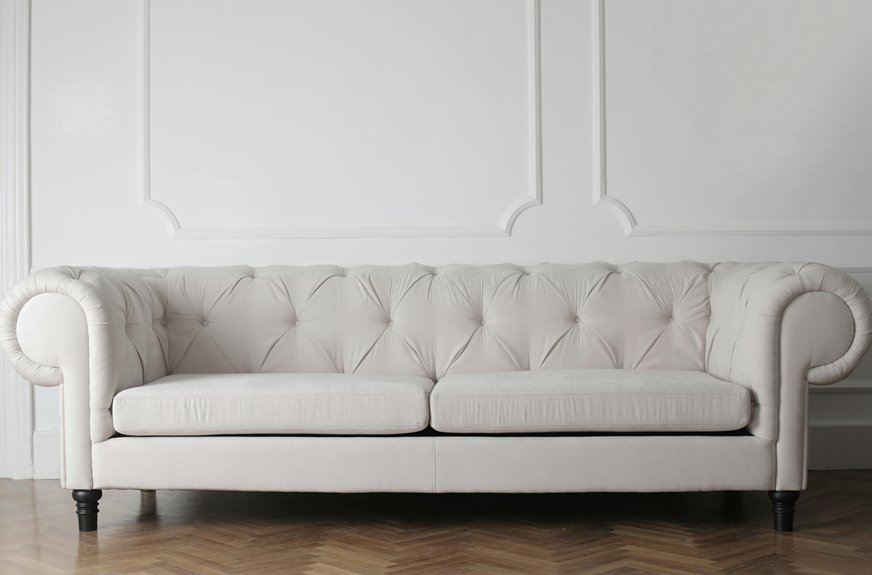When choosing upholstery leather, you’ll want to know the types like full-grain, top-grain, and bonded leather, each offering different durability and looks. Understanding leather grades helps you pick quality that lasts. Genuine leather is strong, ages beautifully, and feels comfortable. To keep it looking great, clean spills quickly and condition it regularly. With the right care and selection, your leather furniture will stay stunning — and there’s even more to discover about making the best choice for your home.
Key Takeaways
- Full-grain and top-grain leathers are the most durable and ideal for high-use upholstery due to their strength and longevity.
- Corrected-grain leather is sanded and embossed for uniformity, offering a budget-friendly but less breathable option.
- Bonded leather is made from scraps fused with polyurethane, providing an affordable but less durable upholstery material.
- Clean leather regularly with a damp cloth and mild soap, and condition it every 6 to 12 months to maintain suppleness.
- Protect leather furniture from direct sunlight and heat to prevent fading, drying, and cracking over time.
Understanding Different Types of Upholstery Leather
Before you choose upholstery leather, it’s important to understand the different types available.
You’ll find several options, each with unique characteristics. Full-grain leather is the most durable and develops a beautiful patina over time, making it ideal for high-use furniture.
Top-grain leather offers a smooth finish and resists stains better, though it’s slightly less durable.
Corrected-grain leather undergoes sanding to remove imperfections, often embossed with a texture, and is more affordable.
Bonded leather consists of leather scraps fused with polyurethane, offering a budget-friendly choice but less longevity.
Finally, nubuck leather feels soft with a velvety texture but requires more maintenance.
Knowing these types helps you pick leather that suits your style, budget, and how much wear your furniture will face.
Exploring Leather Grades and Their Impact on Quality
Leather grades play an essential role in determining the quality, durability, and appearance of your upholstery. When you choose leather, you’ll encounter several grades: full-grain, top-grain, corrected-grain, and bonded leather.
Full-grain leather is the highest quality, showing natural markings and offering exceptional strength and longevity. Top-grain leather is slightly sanded for a smoother look but still durable.
Corrected-grain leather has an artificial grain applied to hide imperfections, making it less breathable but more uniform. Bonded leather contains scraps bonded with polyurethane, which is less durable and wears faster.
Knowing these grades helps you make informed decisions based on how much wear your furniture will face and the look you want. Picking the right grade guarantees your upholstery meets your expectations for both style and endurance.
Benefits of Choosing Genuine Leather for Furniture
When you invest in genuine leather furniture, you’re choosing durability and timeless style that synthetic materials can’t match.
Genuine leather ages beautifully, developing a unique patina that adds character to your space. It’s naturally strong and resistant to tears and punctures, making it ideal for everyday use.
You’ll also appreciate its breathability, which helps regulate temperature and keeps you comfortable year-round.
Genuine leather is easy to pair with various décor styles, offering versatility in any room. Plus, it retains its value well, so your furniture can be a smart long-term investment.
Tips for Maintaining and Cleaning Upholstery Leather
How do you keep your upholstery leather looking its best? Start by dusting it regularly with a soft, dry cloth to prevent dirt buildup.
For spills, blot immediately with a clean, absorbent cloth—never rub, as that can spread stains. Use a damp cloth with mild soap for gentle cleaning, but avoid harsh chemicals or excessive water, which can damage the leather.
Condition your leather every 6 to 12 months using a product suited for your leather type to maintain its suppleness and prevent cracking.
Keep your furniture away from direct sunlight and heat sources to avoid fading and drying out.
Finally, address scratches promptly by gently buffing with your fingers or a leather conditioner. Following these steps helps your leather furniture stay beautiful for years.
How to Select the Perfect Leather for Your Home Decor
What qualities should you prioritize to find the ideal leather for your home decor? Start by considering durability—choose full-grain or top-grain leather for long-lasting wear, especially in high-traffic areas.
Next, think about texture and finish; smooth leather offers a sleek look, while distressed leather adds character and warmth.
Consider texture—smooth leather provides sleekness, while distressed leather brings warmth and character to your space.
Color plays an essential role too—pick shades that complement your existing palette without overwhelming the space.
Don’t forget about maintenance; some leathers resist stains better and are easier to clean.
Finally, factor in comfort—softer, more supple leather enhances coziness.
Frequently Asked Questions
How Does Upholstery Leather Impact Indoor Air Quality?
You’ll notice upholstery leather can affect indoor air quality by releasing VOCs, especially if it’s treated with chemicals. Choosing high-quality, natural leather and proper ventilation helps reduce odors and keeps your indoor air healthier.
Can Leather Upholstery Be Repaired if Scratched or Torn?
When life gives you a scratch or tear in your leather, don’t throw in the towel. You can repair it with kits or professional help, restoring your furniture’s charm without breaking the bank.
What Are the Environmental Impacts of Leather Production?
You should know leather production can harm the environment through high water use, chemical pollution, and greenhouse gas emissions. Choosing responsibly sourced or alternative materials helps reduce these impacts and supports more sustainable practices.
Are There Vegan Alternatives That Mimic Leather Upholstery?
Yes, you can choose vegan leather alternatives like polyurethane or cork. They mimic leather’s look and feel, and you’ll avoid animal products while enjoying durable, stylish upholstery options that are often more eco-friendly too.
How Long Does Upholstery Leather Typically Last?
Wondering how long upholstery leather can last? With proper care, you’ll see it endure 10 to 15 years or more. Don’t you want your furniture to stay beautiful and strong for years to come?

